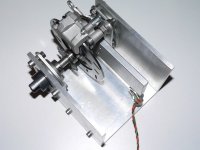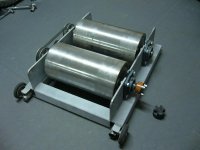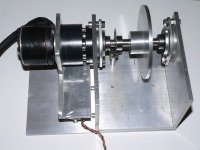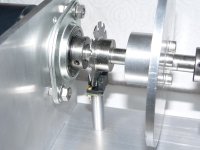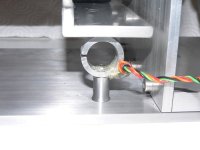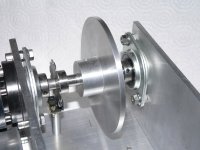Jeremy Harris
100 MW
Whilst developing the simple BLDC controller, I've found that I needed to load the test motor predictably to see how the controller stands up to conditions like high torque, low RPM and make sure that the current limiting and controller protection circuit works properly. I was originally just going to make a simple brake to load the motor, but realised that it needed to be a bit more complex if I was going to be able to make even quite simple measurements of motor load/performance. This has led to me making a pretty universal dyno to test motors up to about 10Nm or so of torque and around 12,000 rpm maximum (equivalent to maybe 12.5kW maximum).
The start of this project is here, in the controller thread: http://endless-sphere.com/forums/viewtopic.php?f=2&t=23350&start=180#p347481 but as it now seems to be a universal dyno, rather than just something to test the controller, I felt it deserved its own build thread.
First I made up a brake, using a 120mm diameter disc brake with the calliper fitted to a free floating reaction arm, pivoted on the motor shaft:
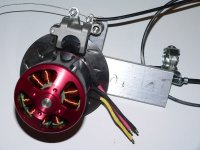
Having made this, I needed a way to measure the torque reaction on the calliper arm, so I made up a small load cell:

This has a full scale range of about 110N, so when fitted 100mm from the shaft centre it will measure up to about 11Nm of torque. It will screw into a pillar bolted to the dyno base plate, with the calliper reaction arm resting on the ball bearing pressed into hole on the top of the load cell.
Having made the load cell and tested it, I realised that it would be more useful to have a stand-alone dyno that could be coupled to any motor fairly easily. It wouldn't be much more work to make a proper dyno, and would be far more useful as a bit of workshop kit. This meant machining up some alloy plate to form a frame, into which will be fitted a pair of flange bearings at either side, to support a 12mm diameter shaft that will carry the disc brake and calliper:
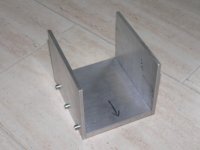
I still need to bore the side plates for the bearings and make up some brackets to hold things, but it's getting there.
Having decided that a stand-alone dyno would be useful, I then realised that having an integral display that shows RPM, torque and motor power would be useful, particularly if the unit could also hook up to a serial port and stream ASCII data to a PC. The load cell needed an amplifier, and it looks easy enough to measure rpm with a sensor fitted close to the disc. The disc already has 12 slots in it, so a slotted opto switch will work a treat to give rpm with decent resolution. Add a small Picaxe 08M microcontroller and a serial display and I have all the ingredients for a simple bench dyno:
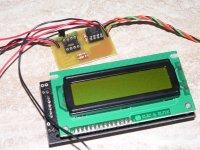
Tomorrow should see the side plates machined up, mountings for the load cell made and a plate to hold the display and electronics. The whole lot will run for hours from a small PP3 9V battery, so no power supply will be needed. If this all works, then I should be able to get some fairly definitive data on motor performance. Might be useful when it comes to looking at things like Burties timing adjuster, as well as the effect of different motor winds.
Jeremy
The start of this project is here, in the controller thread: http://endless-sphere.com/forums/viewtopic.php?f=2&t=23350&start=180#p347481 but as it now seems to be a universal dyno, rather than just something to test the controller, I felt it deserved its own build thread.
First I made up a brake, using a 120mm diameter disc brake with the calliper fitted to a free floating reaction arm, pivoted on the motor shaft:

Having made this, I needed a way to measure the torque reaction on the calliper arm, so I made up a small load cell:

This has a full scale range of about 110N, so when fitted 100mm from the shaft centre it will measure up to about 11Nm of torque. It will screw into a pillar bolted to the dyno base plate, with the calliper reaction arm resting on the ball bearing pressed into hole on the top of the load cell.
Having made the load cell and tested it, I realised that it would be more useful to have a stand-alone dyno that could be coupled to any motor fairly easily. It wouldn't be much more work to make a proper dyno, and would be far more useful as a bit of workshop kit. This meant machining up some alloy plate to form a frame, into which will be fitted a pair of flange bearings at either side, to support a 12mm diameter shaft that will carry the disc brake and calliper:

I still need to bore the side plates for the bearings and make up some brackets to hold things, but it's getting there.
Having decided that a stand-alone dyno would be useful, I then realised that having an integral display that shows RPM, torque and motor power would be useful, particularly if the unit could also hook up to a serial port and stream ASCII data to a PC. The load cell needed an amplifier, and it looks easy enough to measure rpm with a sensor fitted close to the disc. The disc already has 12 slots in it, so a slotted opto switch will work a treat to give rpm with decent resolution. Add a small Picaxe 08M microcontroller and a serial display and I have all the ingredients for a simple bench dyno:

Tomorrow should see the side plates machined up, mountings for the load cell made and a plate to hold the display and electronics. The whole lot will run for hours from a small PP3 9V battery, so no power supply will be needed. If this all works, then I should be able to get some fairly definitive data on motor performance. Might be useful when it comes to looking at things like Burties timing adjuster, as well as the effect of different motor winds.
Jeremy


